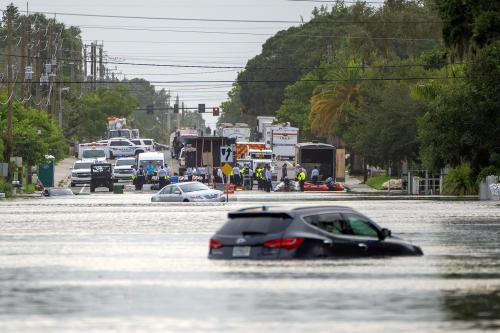There sure is a lot of carbon tax chatter this fall. With the “fiscal cliff” looming and global warming alive and well, numerous voices are suggesting that if we need to raise revenue we should “just do it” and place a moderate fee on carbon emissions.
The economist Robert Frank; the sociologist Theda Skocpol; the blogger Ezra Klein; and my Brookings colleagues Warwick McKibben, Adele Morris, and Peter Wilcoxen have all in the last few months proposed enacting a carbon tax for purposes of averting “Taxmageddon” and discouraging carbon pollution. For its part the MIT Global Change Institute has laid out how such a tax might work in practice. And likewise, Rep Jim McDermott (D-WA) has introduced legislation, while former Rep. Bob Inglis has proposed replacing today’s slew of clean energy subsidies with a carbon fee.
This is all welcome. Yet, it leaves something out: It neglects to think deeply enough about the use of the revenues and the need to make direct investments—soon—in clean energy technology development and deployment.
To be sure, there’s a big opportunity here. Over the years, economists as diverse as Martin Feldstein and Greg Mankiw (an advisor to George W. Bush and now Mitt Romney) on the right and Harvard’s Robert Stavins, on the environmentalist left, have all agreed that a carbon tax represents an efficient option for reducing emissions. That alone points to a grand bargain.
What’s more, a carbon fee could raise a lot of money useful for fiscal stabilization to go along with environmental mitigation. Based on its models, the Brookings team concludes that a $15 per metric ton carbon dioxide assessment rising at 4 percent above inflation each year through 2050 would raise $80 billion at the outset, rising to $170 billion in 2030 and $310 billion a year by 2050. According to the MIT group a $20 levy that rose at a similar pace would raise $1.5 trillion over the next 10 years. So that’s real money that raises the possibility of an inspired, efficient confluence of smart responses both to the fiscal and the climate crises.
However, for all the clever financial engineering and modeling being advanced, there’s been too little talk about the best way to employ all that revenue. Specifically, for all the carbon tax talk there’s been surprisingly little talk about making direct investments—starting right away—in clean energy technology development and deployment.
The sticking point here is that while the conventional wisdom among carbon pricers holds that higher dirty energy prices will provide the right market signals to entrepreneurs, who will then develop and deploy clean new technologies, a ton of evidence suggests that pricing alone won’t generate enough deployment to get us where we need to go. Instead, it is becoming increasingly obvious that along with pricing we need a direct technology deployment push.
One hint of this comes from the modelers. Under neither of their respective carbon tax proposals do the Brookings or MIT groups forecast that emissions will drop enough to even come close to the 80 percent cut in emissions below 1990 levels that is the nation’s long-term carbon emissions goal. Yes, fossil fuel use would go down, oil imports would shrink slightly, and emissions would decline, but much more work would need to be done to tackle global warming. Similarly, an interesting analysis by the Breakthrough Institute concluded that a $20 per ton carbon tax would offer just one-half to one-fifth the incentive of today’s subsidies for the deployment of solar, wind, and other zero-carbon technologies.
These results reflect the growing body of literature that has begun to suggest—and document—that broad economy-wide pricing strategies alone induce only modest technology change and deployment. Last year, Matt Hourihan and Rob Atkinson of the Information Technology and Innovation Foundation ran through some of the literature pertaining to a wide range of industries, while at the same time, scholarship specifically on energy has been accumulating.
Ackerman argued a few years ago that getting the price right is necessary but far from sufficient to mitigate climate change and that direct public sector initiatives are required to disrupt path-dependencies and accelerate learning. Acemoglu and others more recently demonstrated that the optimal carbon policy is not one-sided but involves both carbon taxes and direct research subsidies. They urge immediate action.
Turning to empirical evidence, Calel and Dechezleprêtre llooked at company patenting patterns under the EU emissions trading system (a cap-and-trade pricing scheme) and concluded that the system has had very little impact on low-carbon technology change. And then, earlier this year, a Swiss-German team found that the EU system has stimulated only limited adoption of low-emissions technology and that research, development, and deployment (RD&D) technology “push” measures induced more action. This group concluded that none of the first three phases of the trading system were “capable of triggering increased non-emitting technology adoption” and that “only renewable-technology pull policies had this effect.”
And so we arrive back at the revenue: The accumulating evidence and the appropriate fit of the tax to its use argue heavily for at least a portion of the revenue of any carbon pollution fee to be applied to direct investment in energy system clean-up, whether through R&D or later-stage deployment supports.
Currently, no one is talking about this. But they should be.
Certainly, sound arguments can be mounted that some or much of the revenue from a carbon tax could and should flow beneficially to deficit reduction, maintenance of core discretionary spending, tax cuts, or even rebates to low-income taxpayers. Such arguments have been mounted by Frank, Skocpol, Klein, McDermott, and the MIT group. However, it would be a serious mistake to ignore the need to apply a portion of the money to major direct investments in the accelerated deployment of existing clean energy technologies as well as the development of new ones.
My group at Brookings—along with a long list of others, including Bill Gates’s American Energy Innovation Council, scholars at the American Enterprise Institute and the Breakthrough Institute, as well as at the World Resources Institute—has argued that the nation needs to be investing as much as $15 to $25 billion per year on energy RD&D alone. And that leaves out the need for further deployment and scale-up financing and incentives.
So the need is clear: Should the carbon tax chatter grow any more serious, it needs to take into account the need to supplement modest pricing strategies with the use of some of the revenue for direct technology investments. If that transpires, an incremental gain for environmental and budgetary stabilization could become a huge win for true economic change and climatalogical sustainability.
The Brookings Institution is committed to quality, independence, and impact.
We are supported by a diverse array of funders. In line with our values and policies, each Brookings publication represents the sole views of its author(s).


Commentary
Op-edCarbon Tax Dreams: What About Cleantech Deployment?
October 31, 2012